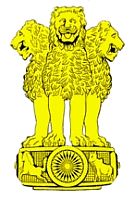National Symbol of India
| Heraldry of the World |
| India heraldry portal दुनिया की हेराल्ड्री |
|
NATIONAL SYMBOL OF INDIA
Origin/meaning
On 26 January 1950, India became a Republic and adopted as her emblem the Lion Capital at Sarnath with the wheel prominently showing. The emblem is a replica of the capital of the 40ft. high column, three of the four lions being visible; on the abacus in bas relief appears the Dharm Chakra between a horse and a bull, and two more Dharm Chakras are just visible on its extreme right and left.
The motto in Devanagri script is sometimes shown under the emblem : transliterated it is Satyameva jayate, meaning "Truth alone triumphs", and is taken from an ancient scripture, the Mundaka Up¬anishad.
The lion pillar at Sarnath dates from the 3rd century B.C. and was erected by the Emperor Asoka to mark the spot where Buddha first proclaimed his message of ahimsa and love to the four quarters of the universe, symbolised by the peaceful attitude of the sitting lions facing four directions. The emblem is said to represent India's objective of universal peace and brotherhood and is in keeping with her resolve to uphold her ancient heritage and the spirit of toleration. The Asoka lions recall the association of the Emperor Asoka with Buddhism. He ruled from 273 to 232 B.C., renounced war and was converted to Buddhism, which under him rose from an obscure sect to the position of the official religion of a vast empire covering the greater part of India.
Colonial arms
The Empire of India as such had no arms : sometimes the Star of the Order of the Star of India was used to represent India, sometimes the Royal arms were used.
Before direct colonial rule the arms of the East India Company were used in the territory of present India.
For the Portuguese colonies, see Portuguese India. The Dutch, Danish and French colonies did not use separate arms.
The use of arms on colonial coins (only Danish, the other powers did not use heraldic symbols on coins:
The use of (colonial) arms on collector's items:
Royal arms (German card +/- 1910)
Royal arms (Abadie albums, 1930s)
Royal arms (German, 1929)
Star of India (Spanish, 1917)
Star of India (tobacco card (1904))
Star of India (German album, 1933)
Modern arms (Brooke Bond)
Unknown composition (Dutch card, 1948/9)
Contact and Support
Partners:
Your logo here ?
Contact us
© since 1995, Heraldry of the World, Ralf Hartemink 
Index of the site



























